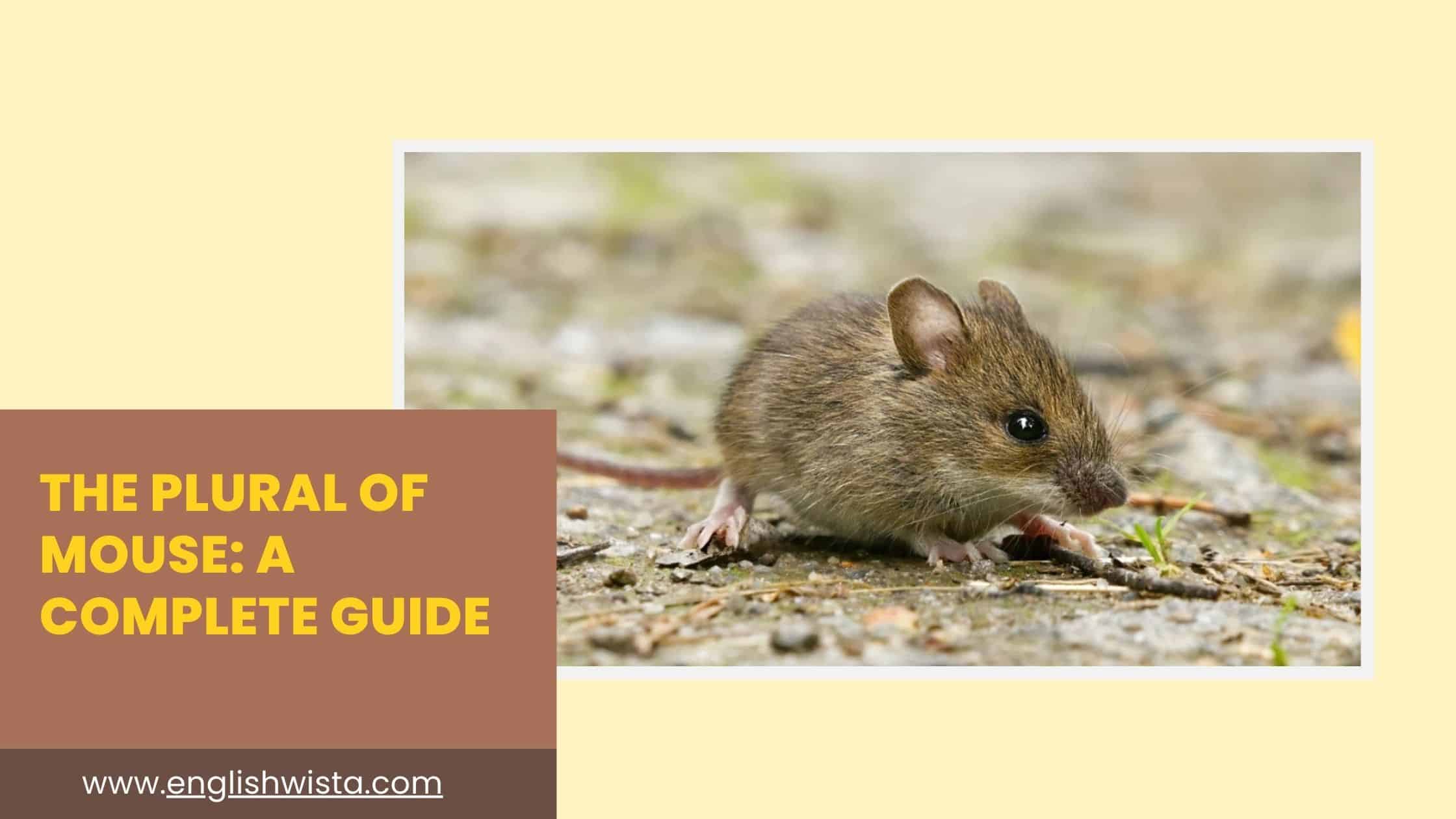Picture this: you’re telling a friend about the cute little creatures you spotted in your garden, or maybe you’re describing the computer accessories on your desk at work. In both cases, you’re talking about more than one “mouse” – but what’s the correct way to say it? Do you say “mouses” or “mice”? And what about those computer devices we click and scroll with every day? This simple question opens up a surprisingly interesting world of English grammar that even native speakers sometimes find confusing. Let’s explore this together and clear up the mystery once and for all!
What Is the Plural of Mouse?
Here’s the straightforward answer: mice is the correct plural form when talking about the small furry animals. For computer mice, both mice and mouse devices are commonly used, though “mice” is becoming more standard.
Let’s break this down clearly:
- Animal mouse → mice (always correct)
- Computer mouse → mice (most common and preferred)
- Computer mouse → mouse devices (also acceptable, especially in technical writing)
The key thing to remember is that “mouses” is generally incorrect in standard English, though you might hear it occasionally in very informal speech or from non-native speakers.
Why Do We Say “Mice” Instead of “Mouses”?
You might wonder why we don’t just add an “s” to “mouse” like we do with most English words. After all, we say “houses,” “books,” and “cars” – so why not “mouses”?
The answer lies in English history. “Mouse” is what we call an irregular noun. These are words that don’t follow the standard pattern of adding “s” or “es” to make plurals. Instead, they change in special ways that come from very old English and Germanic language patterns.
The word “mouse” comes from Old English “mūs,” and its plural was “mȳs.” Over hundreds of years, this evolved into our modern “mice.” This same pattern appears in other words too:
- Goose → geese
- Foot → feet
- Tooth → teeth
- Man → men
These irregular plurals are leftovers from ancient language rules that we still use today.
Understanding the Animal Mouse Plural
When talking about the small furry creatures, mice is always the correct plural. There’s no debate or alternative here – it’s simply the way English works.
Example sentences:
- “Three mice ran across the kitchen floor.”
- “The barn owl hunts mice in the field.”
- “Pet mice need a clean cage and fresh water.”
- “Wild mice can squeeze through tiny spaces.”
- “Laboratory mice are used in medical research.”
Notice how natural “mice” sounds in all these sentences. If you tried to say “mouses” instead, it would sound wrong to most English speakers.
Different Types of Mice
There are many different types of mice in the world, and they’re all called “mice” in plural:
- House mice – the common ones you might find in buildings
- Field mice – small mice that live in grasslands and fields
- Deer mice – mice with white bellies found in North America
- Harvest mice – tiny mice that build nests in tall grass
No matter which type you’re talking about, the plural is always “mice.”
The Computer Mouse Dilemma
Now here’s where things get interesting! When computer mice were invented in the 1960s, people weren’t sure what to call multiple devices. Should they follow the animal pattern and say “mice”? Or should they treat it as a regular English word and say “mouses”?
For a while, both forms were used. Some people felt that computer devices were different from animals and deserved their own plural form. Others argued that since we borrowed the word from the animal (because of the device’s shape and tail-like cord), we should keep the same plural.
Today’s standard: Most dictionaries, style guides, and technology companies use “mice” for computer devices too.
Example sentences:
- “The office ordered new mice for all the computers.”
- “Wireless mice don’t need charging as often as you might think.”
- “Gaming mice often have extra buttons for shortcuts.”
- “These mice have better precision than older models.”
Technical Writing and Computer Mice
In very formal technical documentation, some writers prefer alternatives to avoid confusion:
- “Mouse devices”
- “Computer pointing devices”
- “Input devices”
But in everyday conversation and most business writing, “mice” is perfectly fine and widely understood.
Common Mistakes to Avoid
Let’s look at some errors people make when talking about mice:
Mistake 1: Using “Mouses”
Incorrect: “I saw three mouses in the garage.” Correct: “I saw three mice in the garage.”
“Mouses” isn’t standard English. Even though it follows the regular pattern of adding “s,” “mouse” is an irregular noun that changes to “mice.”
Mistake 2: Mixing Up Animal and Computer Context
Both animal mice and computer mice use the same plural form. Don’t overthink it!
Correct: “The cats caught two mice.” (animals) Correct: “We need two mice for these computers.” (devices)
Mistake 3: Being Inconsistent
Pick one form and stick with it throughout your writing. Don’t switch between “mice” and “mouse devices” in the same document.
Regional and Professional Differences
While “mice” is standard everywhere English is spoken, you might notice some variations:
Professional Settings
IT departments: Almost always use “mice” Computer manufacturers: Usually use “mice” in marketing materials Technical manuals: Sometimes use “mouse devices” for absolute clarity Casual users: Mix of “mice” and descriptive phrases like “computer mouse”
Different English-Speaking Countries
United States: “Mice” for both animals and computers United Kingdom: “Mice” for both animals and computers
Australia: “Mice” for both animals and computers Canada: “Mice” for both animals and computers
The consistency is reassuring! Unlike some other English words that vary by region, “mice” is universally accepted.
Historical Journey of the Word
Let’s take a quick trip through time to see how “mouse” and “mice” evolved:
Old English (before 1100): “mūs” (singular), “mȳs” (plural) Middle English (1100-1500): “mous” (singular), “mys” or “mice” (plural)
Early Modern English (1500-1700): “mouse” (singular), “mice” (plural) Modern English (1700-present): “mouse” (singular), “mice” (plural) Computer Age (1960s-present): Extended “mice” to computer devices
The word has been remarkably stable for hundreds of years!
Memory Tips and Tricks
Here are some ways to remember that “mouse” becomes “mice”:
The Sound Change Pattern
Notice how the vowel sound changes from “ow” to “i”:
- Mouse (rhymes with “house”) → Mice (rhymes with “nice”)
Think of Similar Words
Remember other words that follow the same pattern:
- Louse → lice
- House → houses (wait, this one’s different!)
Actually, that last example shows why “mouse” is special – most words ending in “-ouse” do add “s,” but “mouse” and “louse” are exceptions.
The Family Connection
Think of “mice” as a family word. You wouldn’t say “one mice” – you say “one mouse” and “many mice,” just like “one child” and “many children.”
Collective Nouns for Mice
While we’re talking about groups of mice, let’s explore some fun collective nouns. When mice gather together, you might call them:
- A nest of mice – when they’re in their home
- A mischief of mice – a playful traditional term
- A horde of mice – when there are many of them
Example sentences:
- “A mischief of mice invaded the pantry.”
- “The barn had a whole nest of mice living in the hay.”
- “A horde of mice scattered when the lights came on.”
These collective nouns add color to your writing, though you can simply say “a group of mice” or “many mice” in everyday conversation.
Mouse vs. Mice in Different Contexts
Let’s see how mouse and mice work in various situations:
Pet Store Context
- “This mouse is very friendly.” (one animal)
- “These mice need daily exercise.” (multiple animals)
- “The white mice are more popular than the brown ones.”
Office Context
- “My mouse isn’t working properly.” (one computer device)
- “The new mice arrived today.” (multiple computer devices)
- “Wireless mice are more convenient than wired ones.”
Research Context
- “The mouse showed interesting behavior.” (one lab animal)
- “All mice in the study gained weight.” (multiple lab animals)
- “Laboratory mice require special care.”
Home Context
- “I think there’s a mouse in the attic.” (one animal)
- “We caught three mice in the traps.” (multiple animals)
- “Field mice are different from house mice.”
Teaching Children About Mouse and Mice
If you’re helping children learn this grammar rule, here are some kid-friendly approaches:
The Rhyming Method
“One mouse says ‘house,’ but many mice say ‘nice!'”
The Story Method
“Once there was one little mouse who lived alone. But soon, more friends came to visit, and then there were many mice having a party!”
The Visual Method
Draw one mouse and label it “mouse.” Then draw several and label them “mice.”
Common Questions About Mouse and Mice
“Can I ever say ‘mouses’?”
In standard English, no. However, some very informal speech might use “mouses,” especially among children or non-native speakers learning English. It’s better to stick with “mice.”
“What about Mickey Mouse and friends?”
Even cartoon mice follow the same rule! “Mickey Mouse and his mouse friends” or “Mickey Mouse and other mice.”
“Are computer mice and animal mice related?”
The computer device got its name because early models resembled the animal – they had a rounded body and a long cord that looked like a tail. So yes, they’re linguistically related!
“Do other languages have irregular plurals like this?”
Yes! Many languages have irregular plural forms. English actually borrowed this pattern from its Germanic roots.
Advanced Usage Tips
For more advanced English learners or writers, here are some additional considerations:
Formal vs. Informal Writing
- Formal: “Laboratory mice demonstrated improved cognitive function.”
- Informal: “The pet mice were so cute playing together.”
Both use “mice,” but the surrounding language changes based on formality.
Scientific Writing
In scientific contexts, you might see specific terms:
- “Male mice” and “female mice”
- “Adult mice” and “juvenile mice”
- “Control mice” and “experimental mice”
Technical Specifications
When discussing computer equipment:
- “Optical mice” vs. “laser mice”
- “Wired mice” vs. “wireless mice”
- “Gaming mice” vs. “office mice”
The Global Perspective
English is spoken worldwide, and “mice” is universally understood. However, when English learners from different language backgrounds encounter this word, they might make predictable mistakes:
Spanish speakers might say “mouses” because Spanish plurals typically add “s” Mandarin speakers might struggle with the concept since Chinese doesn’t change word forms for plurals Arabic speakers might find it easier since Arabic also has irregular plurals
The key for all learners is practice and patience. Irregular plurals like “mice” are memorized rather than figured out through rules.
Modern Usage Trends
Language is always evolving, and it’s interesting to see how “mouse” and “mice” are used in our digital age:
Social Media: “My mice died!” (could refer to pets or computer equipment – context matters!) Gaming Communities: “Gaming mice” is the standard term Tech Reviews: “We tested five different mice” is common E-commerce: Online stores list “computer mice” and “wireless mice”
The computer meaning hasn’t replaced the animal meaning – both coexist peacefully in modern English.
Wrapping Up: Your Mouse and Mice Takeaways
Let’s summarize what we’ve learned about this fascinating little word:
The golden rule: Mouse becomes mice, whether you’re talking about animals or computer devices. This is an irregular plural that you simply need to memorize.
Why it matters: Using “mice” correctly shows that you understand English grammar patterns and helps you communicate clearly with other English speakers.
When to use it: Use “mice” in all contexts – formal writing, casual conversation, business communication, and technical discussions.
What to avoid: Don’t say “mouses” in standard English, even though it might seem logical.
Remember, language learning is a journey, and irregular plurals like “mice” are just one stop along the way. Even native speakers had to learn and practice these forms when they were young. The more you use “mice” in sentences, the more natural it will become.
Whether you’re talking about the adorable creatures scurrying through a field or the essential devices that help us navigate our computers, you now have the confidence to use the correct plural form. Next time you see one mouse, and then another, and another, you’ll know exactly what to call them – mice!
The beauty of English lies in these little quirks and historical remnants that make our language unique. “Mice” is a perfect example of how old patterns survive in modern usage, connecting us to speakers from hundreds of years ago who faced the same plural puzzle. Now you’re part of that long tradition of English speakers who know that one small creature is a mouse, but several of them are mice!



